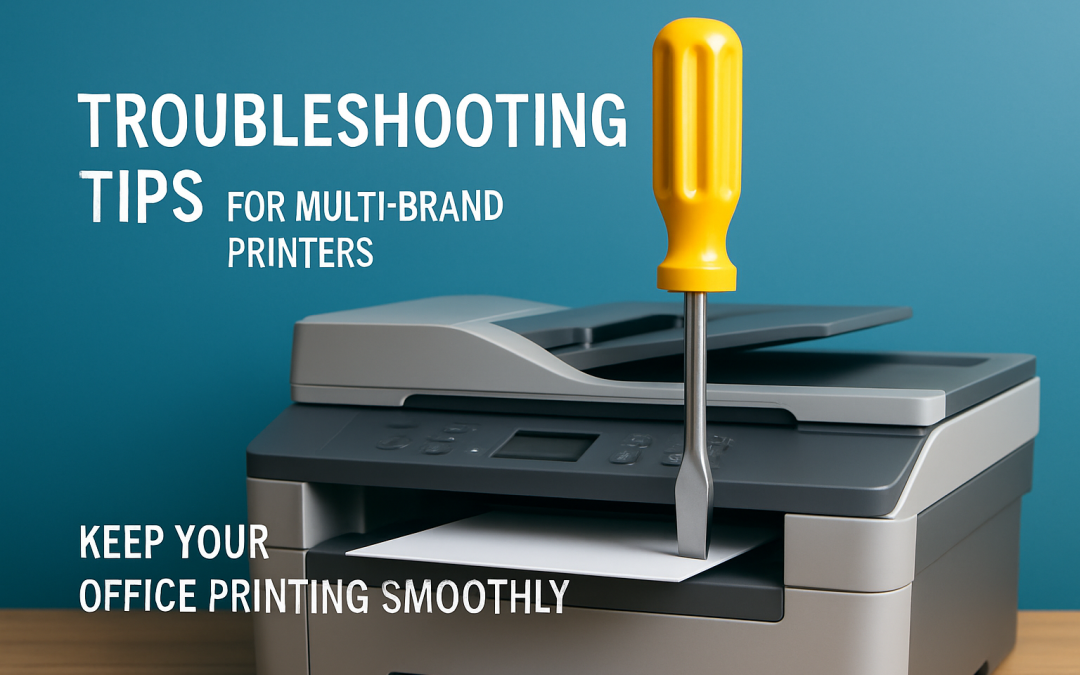10 Essential Troubleshooting Tips for Multi Brand Printers: Keep Your Office Printing Smoothly
You are here because you need reliable, hands-on troubleshooting tips for multi brand printers that actually work across different models and makes. In mixed-brand fleets, a single snag can ripple across departments and stall projects. The good news is that most printer issues follow predictable patterns you can diagnose quickly. With a structured approach, you can reduce downtime, control costs, and make your print environment far easier to manage.
At Printcom, we see the same pain points daily: mysterious error codes, driver conflicts, paper jams, and network hiccups. Yet the fix is often a simple checklist and a few smart settings. Below, you will find practical steps, quick-reference tables, and real-world guidance that apply whether you run Brother, Kyocera, HP, OKI, Fuji Xerox, Samsung, or other supported devices (including scanners from Plustek, Microtek, and Avision). Ready to bring peace to your print room?
Why Multi-Brand Printer Fleets Need Smarter Troubleshooting
In multi-brand environments, small configuration differences turn into recurring headaches. One device may default to Printer Command Language (PCL), another to PostScript (PS), and a third to a proprietary driver. Because each brand ships different utilities, a fix that works for one queue may not work for others. As a result, staff waste time trialing random settings, while help desks chase symptoms instead of root causes.
Consider the impact. Some industry estimates suggest printing can consume 1 to 3 percent of annual revenue, while 20 to 30 percent of information technology (IT) help desk tickets involve print issues. Even a 10-minute delay per user per week adds up to days of lost productivity each quarter. Add untracked reprints and emergency service calls, and your monthly running costs can quietly spiral.
The antidote is a standardized troubleshooting playbook that bridges brand differences. Start with universal checks that solve 60 to 80 percent of problems, then escalate by driver, network path, and firmware. Make sure device records list Internet Protocol (IP) addresses, firmware levels, and driver types, and train staff on a short triage flow. As you will see, the tips below are designed to be brand-agnostic yet precise enough to get you to the fix quickly.
10 Essential Troubleshooting Tips for Multi Brand Printers
-
Validate the Basics: Power, Connections, and Status Lights
It sounds obvious, but the fastest wins live here. Confirm the device is powered on, error-free, and shows a ready state. Inspect cables and switches for loose or damaged connectors, especially on Universal Serial Bus (USB) and Ethernet ports. For wireless fidelity (Wi-Fi), check signal strength at the device and verify the correct Service Set Identifier (SSID) and password are stored.
Next, print a device configuration or status page from the control panel. This page reveals the Internet Protocol (IP) address, firmware version, paper sizes, and tray mappings. If you cannot print locally, you likely have a hardware or consumable issue to address before software troubleshooting. Keep a simple, laminated one-page guide near each device so non-technical users can perform these quick checks and restore service faster.
-
Resolve “Offline” and Queue Stalls by Resetting the Path
Printers often appear offline even when they are accessible. On the workstation, pause and clear the queue, then restart the print spooler service. Re-add the device using the Standard TCP/IP (Transmission Control Protocol over Internet Protocol) port and ensure the IP address is static or reserved via the Dynamic Host Configuration Protocol (DHCP) server. A changing address is a classic cause of intermittent “offline” behavior.
From the device, try printing a network test page. If Domain Name System (DNS) mismatches exist, connect by IP address first, then correct the host name records. For macOS clients, test via Internet Printing Protocol (IPP) over Secure Sockets Layer (SSL) to avoid driver discrepancies. This reset of the end-to-end path fixes a large share of connectivity complaints across brands.
-
Match Drivers to Workloads: PCL, PostScript, or Universal
Driver selection can make or break output quality and reliability. Printer Command Language (PCL) drivers are fast and efficient for text-heavy jobs, while PostScript (PS) often renders graphics and PDFs cleaner. Many vendors offer universal drivers that simplify mixed fleets, but features like finishing, stapling, and hole punch may require model-specific packages.
As a rule, standardize on a primary driver per workflow and document exceptions. For example, publish one queue with PCL for everyday office documents and another with PS for design and marketing teams. If an app misprints, switch drivers on a test queue and compare. This “driver A vs driver B” test quickly isolates the cause without disrupting the entire office.
-
Fix Paper Jams at the Source: Path, Media, and Humidity
Paper jams rarely come out of nowhere. Open each access door in the order shown on the device diagram and remove fragments without tearing. Check rollers for glaze or debris and clean with manufacturer-approved wipes. Verify the tray guides match the paper size and that the stock meets the device’s grams-per-square-meter specification.
Environmental factors matter. High humidity can curl paper, and low humidity can increase static, both leading to misfeeds. Store paper in the wrap until used and fan reams before loading. If a specific tray jams often, swap media between trays to see if the issue follows the stock or the mechanism. Logging jam codes helps you and your service partner spot patterns quickly.
-
Eliminate Streaks, Fades, and Color Casts
Print quality defects usually point to consumables or calibration. For laser engines, inspect toner and imaging units, run cleaning cycles, and check transfer belts. For inkjet devices, run printhead cleaning and alignment routines, and use the self-test nozzle pattern to confirm improvements. Ensure you are using the correct media type setting; plain paper vs coated stock changes fusing and ink laydown significantly.
If colors are off, print a color calibration sheet and verify International Organization for Standardization (ISO) profile settings in your application. Try a different driver or rendering path if vector elements go missing. Consistency across brands improves when you standardize profiles and keep firmware and drivers up to date.
-
Stop “Toner Low” and “Non-Genuine” Surprises
Alerts like “low toner” can appear early and vary by brand. Check actual coverage: heavy graphics burn through supplies faster than the default 5 percent yield assumption. If a device rejects a cartridge as non-genuine, reseat it, clean the contacts, and confirm the part number matches the model and region. Mixing consumables across similar model lines often triggers errors.
To avoid stockouts, set simple reorder thresholds based on average monthly print volumes per device. Printcom can deliver maintenance contracts and consumables supply that balance price with reliability, whether you prefer original equipment manufacturer (OEM) parts or vetted alternatives. This prevents panic purchases and reduces your monthly running costs across the fleet.
-
Conquer Slow Printing and Timeouts
Slow jobs usually mean large files, network congestion, or rendering bottlenecks. Test by printing to a local Universal Serial Bus (USB) cable to rule out the network. If the job flies locally, review switch ports and Quality of Service (QoS) rules. On the application side, flatten complex graphics to a portable document format and remove embedded fonts when possible.
For shared queues, ensure print servers have adequate memory and disk space, and disable unnecessary bidirectional communication. Switching from PostScript (PS) to Printer Command Language (PCL), or vice versa, can dramatically change performance for certain documents. Finally, upgrade device memory if you routinely print large, image-heavy files on entry-level models.
-
Harden Security Without Breaking Printing
Security updates sometimes break trusted paths. If jobs fail after a change, verify Secure Sockets Layer (SSL) and certificate settings on both the device and server. Align Transport Layer Security (TLS) versions and reimport certificates if they expired. For guest and contractor devices, isolate printing via a separate virtual local area network and Internet Printing Protocol (IPP) to avoid policy conflicts.
Lock down with sensible defaults: disable unused protocols, require administrator passwords, and rotate them quarterly. Enable pull-printing or secure release on devices that handle sensitive documents. These steps keep auditors happy and your queues running, without compromising uptime or user convenience.
-
Tame Mobile and Cloud Printing
When staff print from phones or remote laptops, test both the discovery method and the driverless path. AirPrint and Mopria rely on multicast traffic that may be filtered by network policies. If discovery fails, publish a simple, documented path via Internet Printing Protocol (IPP) over Secure Sockets Layer (SSL) or a vendor cloud connector. Keep instructions with screenshots so users can self-serve.
Set default color and duplex options server-side to curb waste. For remote workers, a secure tunnel such as a virtual private network ensures printing without exposing devices to the public internet. If your fleet spans multiple brands, a universal, cloud-based print platform can normalize the experience and reduce support calls.
-
Standardize Firmware and Document the Known Good State
Mixed firmware versions create odd, intermittent faults. Maintain a device inventory that lists model, serial, firmware level, network address, and driver. Before updating, snapshot the current state, apply updates to a pilot device, and test typical jobs from accounting, operations, and design. If it passes, roll out in phases and document any menu or feature changes.
Store your “golden” configuration files and back up address books and scan-to destinations. This discipline turns unknowns into knowns and lets you recover quickly after resets or replacements. Over time, standardization across brands reduces the number of unique fixes you need to remember.
Watch This Helpful Video
To help you better understand troubleshooting tips for multi brand printers, we’ve included this informative video from Professor Messer. It provides valuable insights and visual demonstrations that complement the written content.
Quick Reference Tables for Fast Diagnosis
Use the following tables to accelerate diagnosis across brands. Keep a printed copy in your print room and a digital copy on your intranet. The first table maps common symptoms to likely causes and next actions. The second outlines which driver or protocol to try first based on the workload and device type. These compact guides save minutes that add up to hours saved each month.
| Symptom | Most Likely Cause | Quick Test | Next Action |
|---|---|---|---|
| Printer shows offline | IP address changed, queue stalled | Ping device IP and print config page | Reserve IP via Dynamic Host Configuration Protocol, clear queue, re-add Standard TCP/IP port |
| Slow first page | Driver rendering, large file | Print to Universal Serial Bus cable | Switch PCL vs PostScript, flatten graphics, add memory |
| Frequent jams in Tray 2 | Wrong guides or media | Swap paper between trays | Adjust guides, use vendor-approved stock, clean rollers |
| Faded color | Low toner or miscalibration | Print calibration sheet | Replace consumables, run color calibration |
| “Non-genuine” cartridge | Part mismatch or dirty contacts | Reseat and check part number | Clean contacts, use correct region part, consult vendor |
| Use Case | Recommended Driver/Protocol | Why It Helps | Notes |
|---|---|---|---|
| Office documents | PCL driver, Server Message Block or Internet Printing Protocol | Fast rendering for text-heavy jobs | Set duplex and grayscale defaults to cut costs |
| Design and marketing | PostScript driver | Better vector and font handling | Calibrate color profiles on all devices |
| Mixed-brand fleet | Vendor universal driver | One queue for many models | Verify finishing features per model |
| Mobile users | Internet Printing Protocol over Secure Sockets Layer | Driverless and secure | Document the path and certificate steps |
When To Call The Pros: Printcom’s Cost-Saving Intervention
Sometimes the quickest fix is expert help. If you face repeat jams in a single unit, security policy conflicts, or stubborn driver crashes, on-site diagnosis prevents costly trial and error. Printcom’s qualified repair technicians handle mixed fleets daily and bring brand-specific insight that general guides cannot. Because Printcom is an authorized dealer for Brother, Kyocera, HP, OKI, Fuji Xerox, Samsung, Microtek, and Avision, we can source parts quickly and apply vendor-approved procedures.
Beyond emergencies, consider the economics. One Perth accounting firm printing 60,000 pages per month cut downtime by 42 percent after Printcom standardized drivers, updated firmware, and replaced two high-failure units with midrange models under a five-year extended warranty. Consolidated maintenance contracts and smarter defaults reduced color pages by 18 percent, shaving hundreds off monthly running costs. With rental and leasing options, even growing teams can right-size capacity now without heavy upfront spend.
| Challenge | Typical Hidden Cost | Printcom Intervention | Expected Outcome |
|---|---|---|---|
| Frequent breakdowns | Lost hours and emergency callouts | On-site repair, extended warranty up to 5 years | Predictable spend, faster recovery |
| High consumable spend | Over-ordering and rush shipping | Maintenance contracts and consumables supply | Lower unit costs, no stockouts |
| Mismatched models | Complex support and training | Extensive range of printers and photocopiers to standardize | Fewer drivers, simpler processes |
| Seasonal spikes | Underpowered devices in peak months | Printer rental and leasing options | Scale capacity without capital expense |
Preventive Care Checklist and Policy Templates
Prevention beats firefighting. Adopt a monthly mini-audit: check firmware versions, review jam logs, and validate driver consistency. Wipe rollers and feeds with approved materials, vacuum paper dust, and verify tray labels. Confirm scan-to destinations and address books after directory or password changes. These 20-minute routines cut incidents dramatically, especially in busy departments.
Establish two brief policies. First, a print governance policy that defines default color, duplex, and retention settings per queue to cut waste and protect data. Second, a triage policy that instructs users to run basic checks, capture screenshots or photos of error codes, and log the job type involved. Printcom can help you craft both, tailored to your apps and workflows, and align them with training for new hires.
- Weekly: empty waste toner, check paper storage humidity, and test a sample color sheet.
- Monthly: firmware compare, driver inventory, and queue cleanup on print servers.
- Quarterly: security review, certificate renewal, and audit of user permissions.
- Annually: fleet right-sizing, using Printcom’s usage reports to match device to demand.
If you document these steps and pair them with the troubleshooting tips for multi brand printers above, your environment will be calmer, cheaper, and far more predictable. And when issues outgrow in-house time, one call to Printcom keeps you moving.
Troubleshooting Tips for Multi Brand Printers: Fast FAQ
What is the fastest universal check when nothing prints? Verify the Internet Protocol address on the device still matches the queue and then print a configuration page. If that succeeds, clear the workstation queue and send a small text-only job. What if the same portable document format misprints on one device but not another? Switch drivers between Printer Command Language and PostScript and retest, then update firmware on the device that fails.
How do I prevent constant supply alerts? Set reorder points based on real monthly volumes, not the default 5 percent coverage estimate. Should I centralize or decentralize my queues? Many offices use a hybrid: central queues for governance and pull-printing, with a few direct queues for specialty devices. Printcom helps you choose the model that balances control with speed for your team.
The core promise of this guide is simple: with a standard playbook and a few tools, you can solve most issues quickly across brands. In the next 12 months, imagine converting print chaos into a predictable, low-cost utility that quietly supports every team. What would your workday feel like if print interruptions were rare and brief, not daily and disruptive, thanks to consistent troubleshooting tips for multi brand printers?
Additional Resources
Explore these authoritative resources to dive deeper into troubleshooting tips for multi brand printers.
Elevate Print Reliability with Printcom
Tap Printcom’s extensive range of printers and photocopiers to cut costs and boost uptime with tailored solutions, ongoing maintenance, expert support, on-site repairs, warranties, and rentals.



